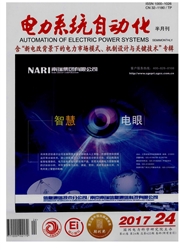

 中文摘要:
中文摘要:
在电热协调概念基础上,结合输电元件随载流变化的电与热之间耦合的规律,以输电元件运行最大允许温度为其热载荷限值,并与传统方法相结合,构建新的动态最优潮流模型。该模型能够实现运行调度中对输电元件随载流变化的热惯性性质的利用,达到有效发挥输电元件输电能力的目的。在此基础上,采用求解微分方程的数值积分方法将该模型转化为代数表达形式的方程,基于内点法进行求解。针对问题的复杂性,进一步结合电热耦合的物理规律,以及内点法迭代过程中修正方程的特点,分别在模型和算法上提出约束数缩减技术和解耦的处理手段,从而降低求解复杂度,提高求解效率。最后通过算例分析验证了该模型和算法的有效性。
 英文摘要:
英文摘要:
Based on electro-thermal coordination (ETC) theory, combining with electro-thermal coupling discipline of transmission element and traditional methods, a dynamic optimal power flow model, which considers the thermal limit, i.e., the maximum permissible temperature of transmission element, is established. It can take advantages of the thermal inertia characteristic of transmission element in operation dispatch to exploit the full transmission capability of transmission elements. Based on this idea, the model is converted into the algebraic form by adopting numerical integrating method, and then it is solved by inter-point method. In addition, according to the characteristics of this model, the discipline of electro-thermal coupling and the corrected equations' characteristics in the iterative process of inter-point method are investigated. To reduce the solving complexity and improve the solution efficiency, the constrains reducing technology and decoupled treatment on model and algorithm are proposed respectively. Finally, a simulation is carried out to demonstrate the validity of the proposed model and algorithm. This work is supported by National Natural Science Foundation of China (No. 50677036).
 同期刊论文项目
同期刊论文项目
 同项目期刊论文
同项目期刊论文
 期刊信息
期刊信息
